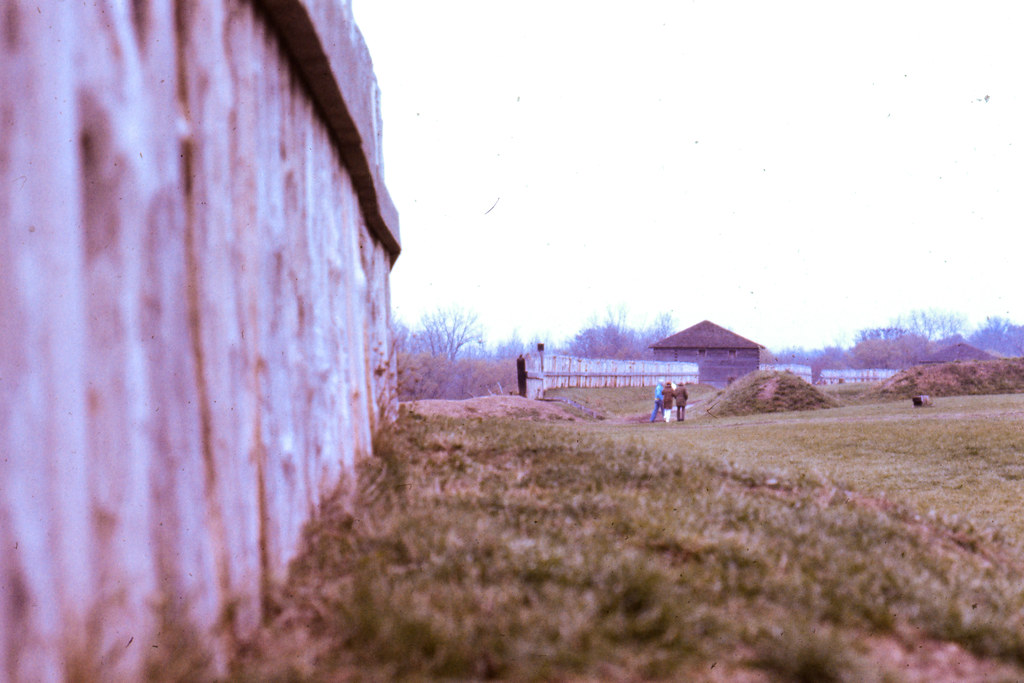#fort meigs
Text
"The past is a foreign country; they do things differently there," is the quote from a mid-20th century novel. The War of 1812 took place decades before the military funeral song "Taps" was written and popularized during the US Civil War.
Alfred Lorrain describes scores of men dying from disease at Fort Meigs in 1812-1813, which was the top killer of soldiers throughout the Napoleonic era:
They died daily. The mournful air of "Roslin Castle" became the prevailing music of the day, while the sharp rifle-cracks of the platoon told how many were borne to their long home. A deadly homesickness overwhelmed our troops, and we believe a repentance of war was kindled in every bosom, from the highest to the lowest.
— Alfred M. Lorrain, The Helm, the Sword, and the Cross.
youtube
It's a haunting melody (and new favorite song). When I was at Fort Meigs historic site earlier in the month there was also a fiddle player in period costume, which was wonderful.
#war of 1812#military history#military funeral#roslin castle#alfred lorrain#fort meigs#ohio#1810s#us army#music#folk music#lorrain's memoir is itself 'a repentance of war'#us history
96 notes
·
View notes
Video
Found Slide by Thomas Hawk
0 notes
Text
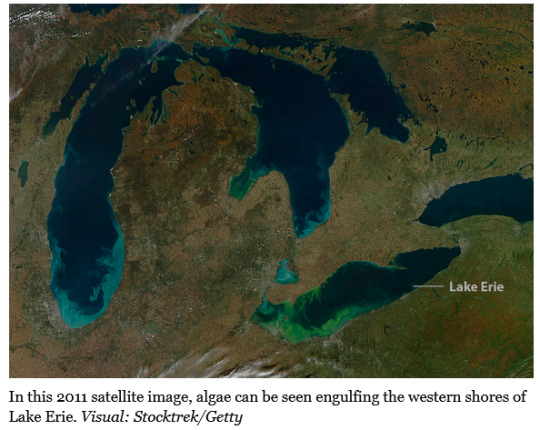

On Saturday, August 2, 2014, the water supply for the city of Toledo, Ohio, was poisoned. Officials issued an unequivocal order to the half million residents connected to the municipal intake: Don’t drink, cook, or brush your teeth with the water. [...] Stores ran out of bottled water, leaving residents to queue up at local fire stations [...]. The culprit was a bright green plume of Microcystis, a cyanobacterium that thrives in warm water [...]. In spring, rains wash a pulse of nutrients off the surrounding region’s fertilized farms and send it down the Maumee and Sandusky Rivers and into western Lake Erie. [...] Tests showed that the city’s water contained dangerous levels of microcystin, a liver toxin produced by the bloom.
The source of the problem stretches for thousands of square miles across northwestern Ohio and eastern Indiana. The rich earth [...] in the region produces hundreds of millions of dollars’ worth of soybeans and corn, as well as wheat, vegetables, pork, and poultry. The landscape is a vast, flat expanse of tidy fields and modest farmhouses crisscrossed with county roads — but it wasn’t always this way.
Centuries ago, this part of the Midwest was a wild expanse of wet forest and marsh stretching across a million acres, and early settlers who slogged through the muck and mosquitoes called the place the Great Black Swamp. [...] On an 1808 map, the swamp, which covered most of northwestern Ohio, was designated as “land not worth a farthing.”
But settlers came anyway, felling the giant sycamores and oaks to create roads, and digging miles of drainage trenches to slowly bleed the water away from the muck. [...]
They [”the wetlands”] are considered a menace, a threat, a thing to be overcome. These attitudes are enshrined in state law, which makes impossible any action, including wetland restoration, that slows the flow of runoff through those miles of constructed drainage ditches [...].
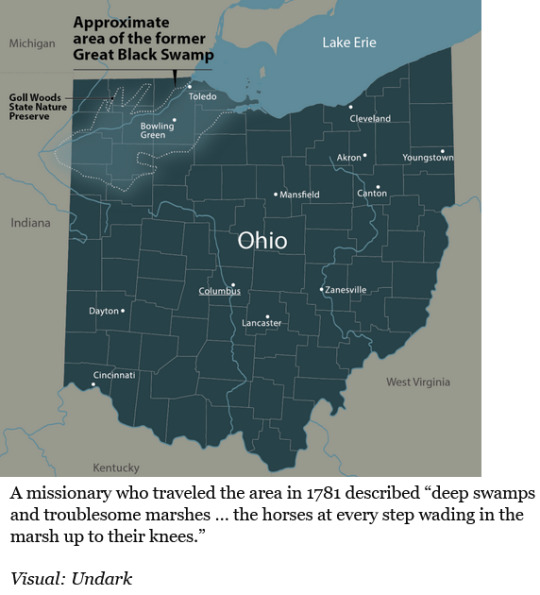
[S]oldiers recorded the striking bounty of the Black Swamp and Lake Erie’s southwestern shore. On an April morning in 1813, two hungry soldiers stationed at Fort Meigs, near present-day Toledo, walked down to the Maumee River. The clear waters swarmed with perch, muskellunge, sturgeon, and catfish. Plunging spears into the water at random, they caught 67 fish in 30 minutes, often killing two or three with a single stroke. Every river mouth west of the Sandusky held dense beds of wild rice, where waterfowl settled to feed, then rose in flocks that darkened the sky. The rice stalks stood taller than a man’s head: to feed, ducks grabbed the stems with their feet and tugged the seed heads down to the water. [...]
In 1859, the Ohio General Assembly passed a law authorizing county commissioners to construct drainage ditches. Farmers benefiting from ditch construction shared the cost. The other Midwestern states also enacted laws authorizing drainage districts, enabling the construction of vast networks of ditches that drained great swathes of land — a mission that required investment and coordination, and could not have been accomplished by individual landowners.
Through the work of drainage districts, the Corn Belt states would lose more than 95 percent of their native wetlands. [...]
Some enterprising soul tested the abundant clay that lay a foot or two beneath the soil of the Black Swamp, and found that it made excellent tiles.
By 1880, more than 50 tile factories operated in northwest Ohio, and the Black Swamp was dismembered and used to feed an accelerating and diversifying cycle of human industry.
The great wetland trees — ash, elm, oak, sycamore — were felled and used to build houses, make furniture, and power the railroads that sprouted up across Ohio. In the 1860s, Ohio’s railways consumed one million cords of wood each year as fuel, and an unknown quantity for ties. The discovery of underdrainage created a growing demand for tile. All this drove an orgy of forest clearing and land draining which in the course of five decades, from 1870 to 1920, completely erased the Black Swamp. A wilderness went up in the smoke from railroad engines, and flowed in drainage ditches down to the Maumee and Sandusky, which began to run murky and lost their once-bountiful populations of fish.
Among the descendants of the settlers who conquered the Black Swamp, drainage is viewed as sacred, while wetland restoration borders on the profane. In terms of water quality, a prime place to create wetlands would be where they intercept the flow of polluted water in farm ditches. That could cause water to back up and flood the fields, however, and it is forbidden under Ohio’s ditch laws, which have changed little since 1859.

-------
All text, images, and captions published by: Sharon Levy. “Learning to Love the Great Black Swamp.” Undark. 31 March 2017. [Bold emphasis and some paragraph breaks added by me.]
2K notes
·
View notes
Photo


Fort Meigs, Memorial Day weekend 2023.
Fort Meigs is the largest timber palisade fort built in North America.
Built on the banks of the Maumee River outside of present-day Perrysburg Ohio under the command of Gen. WIlliam Henry Harrison in February 1813 during the War of 1812. Following the defeat of Gen. WInchester’s forces at River Raisin/Frenchtown and the surrender of Gen. Hull at Detroit, US forces quickly needed to establish a fortified position and supply point for eventual operations into Canada and to recapture Detroit. Unsuccessfully besieged by British and native forces in 1813, the fort was dismantled after British forces departed the area, and was abandoned soon after the war. It was reconstructed in the 1960s on the same site featuring the extant original earthworks.
2 notes
·
View notes
Text
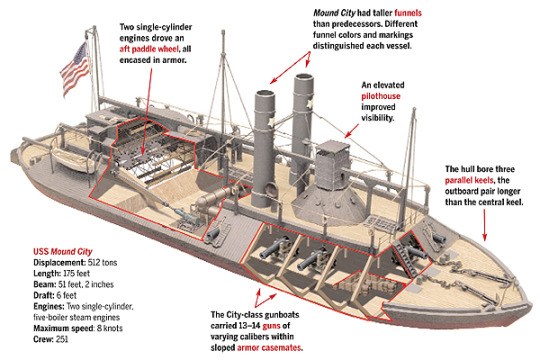
On Aug. 7, 1861, soon after the Union defeat at Manassas, Va., made it clear the Civil War would not end quickly, Union Quartermaster General Montgomery C. Meigs awarded engineer James B. Eads a contract to build seven armored gunboats for the Army’s Western Gunboat Flotilla. The City-class gunboats—designed by Eads, Commander John Rodgers and naval constructor John Lenthall and modified by Eads and naval architect Samuel M. Pook—were all commissioned by February 1862. “Pook’s Turtles,” as they were known, soon established themselves as the most powerful warships in the Western theater of operations.
The City-class gunboats differed only in detail. Mound City, whose specifications are listed in the illustration here, saw action along the Mississippi at Island No. 10, Fort Pillow/Plum Point Bend, Steeles Bayou, Grand Gulf and Vicksburg, as well as on the White and Red River campaigns. On May 10, 1862, off Fort Pillow, Confederate rams twice struck the Union gunship, which withdrew to shallow water and sank; Union shipwrights quickly returned it to service. During the bombardment of St. Charles, Ark., on June 17, 1862, a Rebel shore battery penetrated Mound City’s armor and steam drum, killing 125 of its crew and scalding another 25. Repaired once again, the gunboat served through war’s end and was decommissioned within weeks of the surrender at Appomattox.
0 notes
Text
Oliver House, Maumee Bay Brewing Comapany
The Oliver House is a former hotel which now is actively open as a Brewery, pub, Steakhouse, cafe and museum. The Oliver House is Located in the downtown district of Toledo, Ohio At 27 Broadway St.
The Oliver House is named after Major Williams Oliver, (Major Williams Oliver was known for fighting in the war of 1812 at Fort Meigs). The Oliver House was said to be predating the city of Toledo by almost 2 decades, And it was said that from 1817 -1833 The area hosted buildings acting as saloons and shared room hotels. It was the only known source of entertainment in the area at the time.
It wasn't until 1859 When Major William Oliver Commissioned a gentleman by the name of Isaiah Rodgers to build a luxury hotel. Isaiah Rodgers did just that creating a luxury hotel with 171 rooms with running water, gas lighting and fireplaces. The hotel offered private rooms with grand views of the river. It was a modern wonder to all who came to the newly thriving city.
Along with the grand hotel Isaiah Rodgers gained national recognition as Chief of the Bureau of Construction in the U.S. Treasury Department, a position appointed to him by President Lincoln. Lincoln also was one known president to stay in the luxurious Oliver House Hotel while visiting the city for a funeral.
Just 2 years after the construction of the Hotel, Civil war had broken out. The thriving hotel became one of main passages for the underground Railroad, mainly due to its location to the river. If you visit the Oliver House today located in the basement is a brick archway where the slaves would travel through and out upon the river awaiting their way to Canada.
The Oliver House Hotel thrived until around 1894 and the hotel became vacant due to the modern electricity taking over and leaving little to no desire for gas lighted establishments. Just 1 year later in 1895 The vacant hotel was officially "Not Running." The hotel warehouse sat vacant and became a flop house causing much drama and possible murders & death..
Until the 1900 When the Spanish American war broke out And the hotel was once again opened and acted as a informory for veterans of the war. Injured soldiers were brought by train to the makeshift infirmary where the second floor of the hotel was transformed into a hospital for sick and injured soldiers. The basement was suspected to be the morgue for the deceased.
One well known military apparition known as "The Captain" has been reported to roam the halls in the Oliver house. The Captain has been seen in the Dining room and Pool room, other reports claim to have seen him in the elevator shaft and on the staircase. The Captain is known to have a kind disposition and seems happy to see updates and patrons still roam the hotel.
After the hotel was used for its infirmary purposes in 1919 a gentleman by the name of Edward D Riddle took over the hotel. Edward had the hotel gutted clean leaving only the shell of the historical Hotel. Edwards had the empty space constructed into an industrial plant.
Almost 20+ years later the Now transformed Oliver house Hotel, infirmary, and plant was once again turned over in 1947 And became the Wheel and Axle manufacturer.
It wasn't until another 20 years in 1967 when the building had changed again now becoming storage of novelty items for the Successful Sales Co Along with other small businesses.
During the renovations in the 1960's a garage door was to be installed in the building, while the construction crew dug up the foundation they had discovered human remains. There is no real report as to what happened to the said remains. Some rumors say the Construction crew who originally found the remains left them and built over them. Other reports say they were dug up and placed in a nearby cemetery. The remains were later Named "The Grandfather". Other rumors reported that William Oliver himself was buried under the basement and when the soil was examined it was reported the soil had come from Transylvania. Leading a suspicion that William Oliver was a vampire. This was never noted as fact. It was on the other hand That the Oliver House was known to be built on ancient Indian burial lands.
During the next 20 years there seemed to be a calm and quiet disposition with the ever changing building. Maybe a quiet before the storm,
The Oliver House sat in some state of peace.
Until the 1980's when parts of the building were being rented out to local bands for rehearsals and practice. One musician claimed seeing an apparition of a woman in a long white dress standing at the staircase leading from the private dining room. This Ghostly woman has since been referred to as the "White Lady."
Now It would be almost 50 years later before the building took on another owner. In 1990 Jim and Pat Appold Took over ownership of the historical Oliver House. It was then when the duo decided to have some renovations done to the old building. That is when the real ghostly things started to happen. Contractors reported missing tools, voices in the pool and dining room, and other strange noises. One contractor reported his name being called several times to see no one there. Another worker rushed out of the building after hearing footsteps following him. A bricklayer, while working on the building during the 1990s renovation, was fixing up an apartment in one of the units, where he could stay during this work endeavor. When going up the various staircases to get to his room one evening, he heard the heavy footsteps of an unseen presence following up after him, which would stop when he stopped and continued when he did. He made a hasty bee-line into the apartment. Perhaps this is an entity of a soldier who had died in the building.
In 1994 During said reconstruction Remains were again found under all the brick and concrete, they were presumed to be from the ancient burial Grounds. So a tribe from the west was called out to rebury the remains and perform a ceremony.
In 1995 The completion of remodeling was over and the opening of the Oliver House & Now Maumee Bay brewing company had reopened the doors offering Brews from century old recipes. During the first few years that the Appolds opened up the pub-restaurant, their daughter and son-in-law helped to run the business. The daughter said she was in the private dining room one night where she heard a cheery but faded voice calling her name, the voice was coming from the half-finished pool room, located directly below the private dining room area
The Oliver house holds a long running and fluctuating history, With all this building had seen There is bound for some ghostly sightings, Such as the white lady and The captain, Still to this date there are several haunting reports of the Oliver House. Some of these include hearing the floorboards creak under the weight of an unseen presence. Doors open and close with no assistance, they also become stuck for no apparent reason. People get chills and feel cold spots in this room. People feel an unseen presence watching them. Some of the areas that are reported to see activity is the staircase, the pool room and dining room. The elevator and basement had reports of sightings.
Upon my own visit in the liver house the hostess had confessed being touched on her arm by an unseen person while standing in the lobby at her post. I myself experienced a bit of uncomfortable watching feeling while exploring the walls in the downstairs restroom. Unfortunately I did not experience “The Captain '' nor the “White Lady’ but maybe in one of my future visits I'll get the opportunity.
A psychic who investigated the building had reported a lot of uneasy, unhappy energy here, left over from some traumatic experiences of the past, which could have come from disgruntled Indian spirits, soldiers, or the flop house experiences or some other unfortunate event.
In Closing Toledo Ohio's oldest building and very haunted Oliver House / Maumee Brewing Company holds a deep dark and ghostly history nestled among the beautiful brick walls and wooden staircases. With plenty of hauntings and ghostly guests who still remain.
The Oliver House Maumee Bay Brewing Company is a place to mark on your map of places to see, So if you find yourself in city of Toledo make sure to travel down by the river and enjoy a meal and some on the spot brews and maybe you will have your very own paranormal encounter at the Beautiful Historical and Haunted Oliver House / Maumee Bay Brewing Company.
*As of Now I am Aware this Establishment is open during the pandemic.
for dine and carryout.
For more information on this establishment go to www.mbaybrew.com
1 note
·
View note
Photo
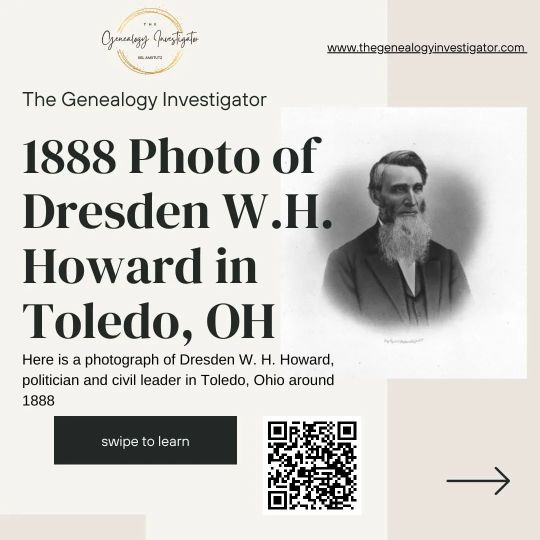
Sit Back Saturday * 1888 Photo of Dresden W.H. Howard in Toledo, OH * Here is a photograph of Dresden W. H. Howard, politician and civil leader in Toledo, Ohio around 1888. * Dresden Winfield Huston (D.W.H.) Howard was born 3 Nov 1817 in Dresden Yates County, New York. His family moved to Fort Meigs (Maumee, Lucas, Ohio) when he was 3 years old. * He served as a negotiator between the government and the Odawa Native American tribe in NW Ohio. He was a frequent advocate on behalf of the Odawa. Howard named the first Fulton County seat, Ottokee, Ohio, after a local Odawa chief of the same name. He also served as the first president of the Fulton County Historical Society. * Howard aided in the Underground Railroad, helping slaves reach freedom in Ohio. He also served as a Senator in Ohio. * He died of cancer on 9 Nov 1897 in Winnameg. He was laid to rest near his home in Winameg, near the tomb of the Odawa Chief Winameg. His tomb was of his own making. * There is a life-size depiction of Dresden Howard displayed at the Sauder Village in Archbold, Ohio. * Want MORE Time Travel in Toledo, Ohio? Check out my website at: https://www.thegenealogyinvestigator.com/time-travel-in-toledo-ohio --- #genealogytribe #thegenealogyinvestigator #genealogy #toledoohiohistory #toledohistory #toledoohio #historynerd #ancestry #familyhistory #timetravelintoledoohio #pioneers #woodcountyohio #easttoledoohio #beards #charlescoy #businessmen #mustaches #suits #vintageclothing #politicians #civilleaders #linguist #indians #dresdenhoward #fultoncountyohio #archboldohio https://www.instagram.com/p/CiU4OEIugep/?igshid=NGJjMDIxMWI=
#genealogytribe#thegenealogyinvestigator#genealogy#toledoohiohistory#toledohistory#toledoohio#historynerd#ancestry#familyhistory#timetravelintoledoohio#pioneers#woodcountyohio#easttoledoohio#beards#charlescoy#businessmen#mustaches#suits#vintageclothing#politicians#civilleaders#linguist#indians#dresdenhoward#fultoncountyohio#archboldohio
0 notes
Photo

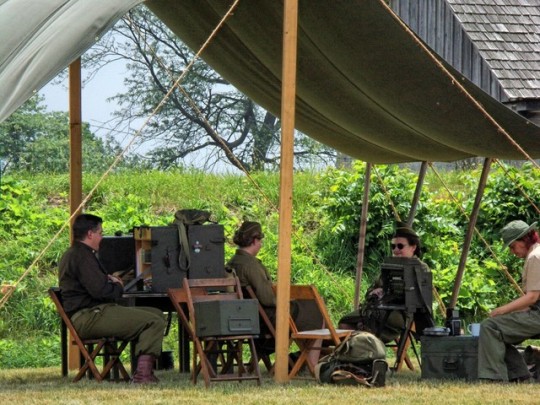

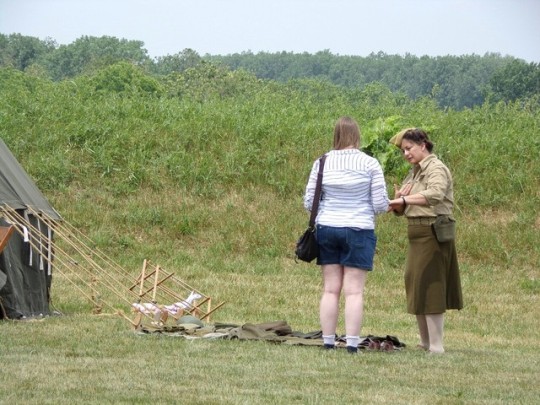
This Saturday I attended Muster on the Maumee at Fort Meigs in Perrysburg, Ohio. My sole reason for going was to meet the 1st WAC Separate Battalion because they’re the reenacting group I’ve been talking to on Facebook. (that’s me in the last pic btw. in the blue shirts and white top. my mom snuck a photo without me knowing). They were really nice girls and they were so welcoming!! They showed me around and let me hang out with them and we just chatted. I hope I didn’t overstay my welcome or come across weird or something. They were so nice. I’d love to join them officially! Just gotta get me a uniform now!
#wac#waac#1st wac separate battalion#wwii#wwii reenacting#women in wwii#women reenactors#stephs stuff#fort meigs#muster on the maumee#my pics
21 notes
·
View notes
Photo

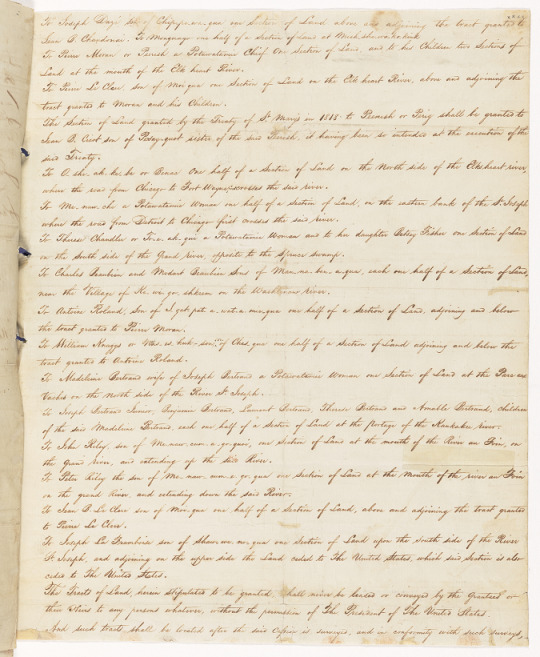
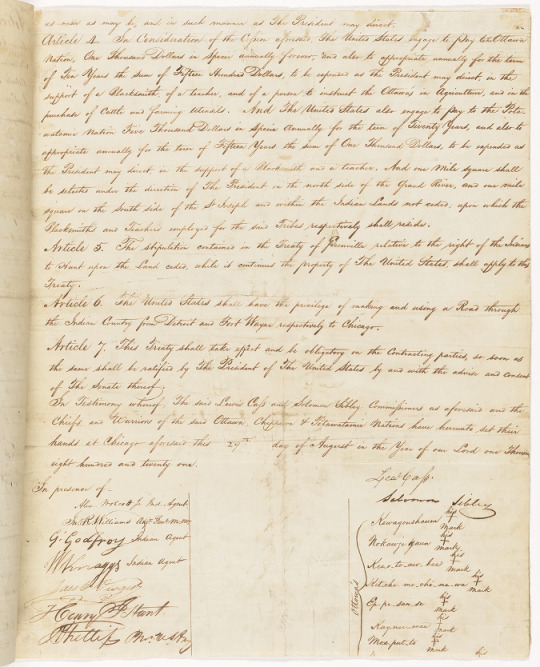
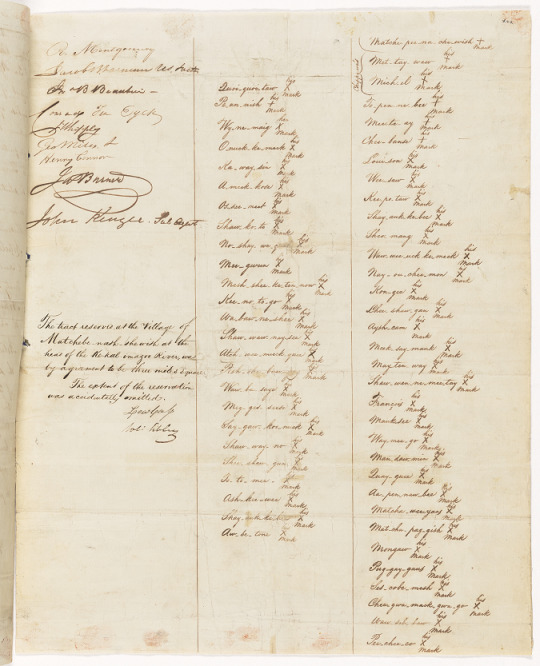
Treaty Between the United States and the Ottawa, Chippewa, and Potawatomi Indians Signed at Chicago, Illinois, 8/29/1821
File Unit: Ratified Indian Treaty 117: Ottawa, Chippewa and Potawatomi - Chicago, August 29, 1821, 1789 - 1869
Series: Indian Treaties, 1789 - 1869
Record Group 11: General Records of the United States Government, 1778 - 2006
Transcription:
Articles of a Treaty made and concluded at Chicago in the State of Illinois between
Lewis Cass and Solomon Sibley Commissioners of The United States, and the Ottawa, Chippewa, and
Pottawatamie Nations of Indians.
Article I". The Ottawa, Chippewa and Pottawatamie Nations of Indians Cede to the United States all
the Land comprehended within the following boundaries: Beginning at a point on the South bank of the River
St. Joseph of Lake Michigan, near the parc aux Vaches due North from Rum's Village, and running thence
South to a line drawn due East from the Southern extreme of Lake Michigan, thence with the said line East
to the tract, ceded by the Pottawatamies to the United States by the Treaty of Fort Meigs in 1817. if the said
line should strike the said Tract, but if the said line should pass North of the said Tract, then such line shall
be continued until it strikes the western boundary of the Tract ceded to the United States by the Treaty of Detroit
in 1807, and from the termination of the said line following the boundaries of former cessions to the main branch
of the Grand River of Lake Michigan, should any of the said lines cross the said River, but if none of the said
lines should cross the said River, then to a point due east of the source of the said main branch of the said
River, and from such point due West to the source of the said principal branch, And from the crossing of
the said River, or from the source thereof, as the case may be, down the said River, on the north bank thereof
to the mouth; thence following the shore of Lake Michigan to the south bank of the said River St. Joseph,
at the mouth thereof and thence with the said south bank to the place of beginning.
Article 2. From the Cession aforesaid, there shall be reserved, for the use of the Indians, the following Tracts,
One tract at Mang-ach-qua Village on the river Pebl'e, of six Miles square. One tract at Mick-ke-saw-be- of
six Miles square.
One Tract at the Village of Na-to-wa-se-pe of four miles square.
One Tract at the Village of Prairie ronde of three Miles square.
One Tract at the Village of Match-e-be narh-she-wish, at the head of the Kekalamazoo river.
Article 3. There shall be granted by The United States, to each of the following persons, being all Indians
by descent, and to their heirs the following tracts of Land.
To John Burnet, two sections of Land.
To James Burnet, Abraham Burnet, Rebecca Burnet, and Nancy Burnet each one section of Land. which said
John, James, Abraham Rebecca and Nancy are Children of Kaw-kee-me sister of Top-ni-be principal Chief of the
Potowatamie Nation.
The land granted to the persons immediately preceding shall begin on the north bank of the river St. Joseph,
about two miles from the mouth and shall extend up and back from the said river for quantity.
To John B. La Lime son of Noke-no-qua one-half of a Section of land, adjoining the tract before granted,
and on the upper side thereof.
To Jean B. Chandonai son of Chip-pe-wa-qua two Sections of Land on the river St. Joseph, above and ad-
-joining the tract granted to J. B. La Lime.
[page 2]
To Joseph Dazé son of Chip-pe-wa-qua one Section of Land above and adjoining the tract granted
to Jean B. Chandonai. To Monguago, one-half of a Section of Land, at Mish-she-wa-ko-kink.
To Pierre Moran or Peeresh a Potawatamie Chief One Section of Land, and to his Children two Sections of
Land at the mouth of the Elk heart River.
To Pierre Le Clerc, son of Moi qua one Section of Land on the Elk heart River, above and adjoining the
tract granted to Moran and his Children.
The section of land granted by the Treaty of St. Mary's, in 1818 to Peeresh or Perig shall be granted to
Jean B. Cicot son of Pe-say-quot sister of the said Peeresh, it having been so intended at the execution of the
said Treaty.
To O-she-ak-ke-be or Benac one half of a Section of Land on the North side of the Elksheart river,
where the road from Chicago to Fort Wayne first crosses the said river.
To Me-naw-che a Potawatamie Woman one half of a Section of Land, on the eastern bank of the St. Joseph
where the road from Detroit to Chicago first crosses the said river.
To Theresa Chandler or To-e-ak-qui a Potawatamie Woman and to her daughter Betsey Fisher one Section of Land
on the South side of the Grand River, opposite to the Spruce Swamp.
To Charles Beaubien and Medart Beaubien Sons of Man-na-ben-a-qua, each one-half of a Section of Land,
near the Village of Ke-wi-go-shkeem on the Washtenaw river.
To Antoine Roland, son of I-gat-pat-a-wat-a-mie-qua one half of a Section of Land, adjoining and below
the tract granted to Pierre Moran.
son
To William Knaggs or Was-es-kuk-son^ of Ches-qua one half of a Section of Land adjoining and below the
tract granted to Antoine Roland.
To Madeline Bertrand wife of Joseph Bertrand a Potawatamie Woman one Section of land at the Parc aux
Vaches on the north side of the River St. Joseph.
To Joseph Bertrand Junior, Benjamin Bertrand, Laurent Bertrand, Theresa Bertrand and Amable Bertrand, children
of the said Madeline Bertrand, each one half of a Section of Land at the portage of the Kankakee river.
To John Riley, son of Me-naw-cum-a-go-quoi, one Section of Land, at the mouth of the river au Foin, on
the Grand River, and extending up the said River.
To Peter Riley the son of Me-naw-cum-e-go-quoi, one Section of Land at the mouth of the river au Foin
on the Grand River, and extending down the said River.
To Jean B. Le Clerc son of Moi-qua one half of a Section of Land, above and adjoining the tract granted
to Pierre Le Clerc.
To Joseph La Framboise son of Shaw-we-no-qua one Section of Land upon the South side of the River
St. Joseph, and adjoining on the upper side the Land ceded to The United States, which said Section is also
ceded to the United States.
The Tracts of Land, herein stipulated to be granted, shall never be leased or conveyed by the grantees or
their Heirs to any persons whatever, without the permission of The President of the United States.
And such tracts shall be located after the said Cession is surveyed, and in conformity with such surveys,
[page 3]
as near as may be, and in such manner as The President may direct.
Article 4. In Consideration of the Cession aforesaid, The United States engage to Pay to the Ottawa
Nation, One Thousand Dollars in Specie annually forever, and also to appropriate annually for the term
of Ten Years the sum of Fifteen Hundred Dollars, to be expended as the President may direct, in the
support of a Blacksmith, of a Teacher, and of a person to instruct the Ottawas in Agriculture, and in the
purchase of Cattle and farming Utensils. And the United States also engage to pay to the Pota-
-watamie Nation Five Thousand Dollars in Specie Annually for the term of Twenty Years, and also to
appropriate annually for the term of Fifteen Years the sum of One Thousand Dollars, to be expended as
the President may direct, in the support of a Blacksmith and a Teacher. And one Mile square shall
be selected under the direction of The President, on the north side of the Grand River, and one mile
square on the South side of the St. Joseph and within the Indian Lands not ceded, upon which the
Blacksmiths and Teachers employed for the said tribes respectively shall reside.
Article 5. The stipulation contained in the Treaty of Greenville relative to the right of the Indians
to Hunt upon the Land ceded, while it continues the property of The United States, shall apply to this
Treaty.
Article 6. The United States shall have the privilege of making and using a Road through
the Indian Country from Detroit and Fort Wayne respectively to Chicago.
Artcile 7. This Treaty shall take effect and be obligatory on the Contracting parties, so soon as
the same shall be ratified by The President of the United States by and with the advice and consent
of The Senate thereof.
In Testimony whereof, The said Lewis Cass and Solomon Sibley Commissioners as aforesaid and the
Chiefs and Warriors of the said Ottawa, Chippewa, + Pattiwatimie Nations have hereunto set their
hands at Chicago aforesaid, this 29th day of August in the Year of our Lord one Thousand
eight hundred and twenty-one.
In presence of —
Alex. Wolcott Jr. Ind. Agent. Lewis Cass,
Jno. R. Williams, Adjt. Genl. M. Ma. Solomon Sibley.
Ottawa's{ [written vertically]
G. Godfroy Indian agent Kewagoushcum his + mark
W. Knaggs Indian agent Nokawjegaun his + mark
Jacob Visget Kee-o-to-aw-be his + mark
Henry I. Hunt Ket-che-me-chi-na-waw his + mark
A. Phillips PMsr. US Army Ep-pe-san-se his + mark
Kay-nee-wee his + mark
Mo-a-put-to his + mark
[page 4]
Mat-che-pee-na-che-wish his x mark
R. Montgomery Chippewa's{Met-tay-waw his x mark
Jacob B. Varnum US factor {Mich-el his x mark
John B. Beaubien - Quoi-quoi-taw his x mark To-pen-ne-bee his x mark
Conrad Ten Eyck Pe-an-nish his x mark Mee-te-ay his x mark,
J. Whipley Wy-ne-naig his x mark Chee-banse his x mark
George Miles J Onuck-ke-meck his x mark Loui-son his x mark
Henry Connor Ka-way-sin his x mark Wee-saw his x mark
James Barnerd A-meck-kose his x mark Kee-po-taw his x mark
John Kenzie. Sub Agent Os-see-meet his x mark Shay-auk-ke-bee his x mark
Shaw-ko-to his x mark Sho-mang his x mark
No-shay-we-quat his x mark Waw-we-uck-ke-meck his x mark
Mee-gwun his x mark Nay-ou-chee-mon his x mark
Mes-she-ke-ten-now his x mark Kong-gee his x mark
Kee-no-to-go his x mark Shee-shaw-gan his x mark
The tract reserved at the Village of Wa-baw-nee-she his x mark Aysh-cam his x mark
Matchebe-nash-she-wish at the Shaw-waw-nay-see his x mark Meek-say-mank his x mark
head of the Ke-kal-imazoo River, was Atch-wee-muck-quee his x mark May-ten-way his x mark
by agreement to be three miles square. Pish-she-baw-gay his x mark Shaw-wen-ne-me-tay his x mark
The extent of the reservation Waw-ba-saye his x mark Francois his x mark
was accidentally omitted. Meg-ges-seese his x mark Mauk-see his x mark
Lewis Cass Say-gaw-koo-nuck his x mark Way-me-go his x mark
Sol: Sibley Shaw-way-no his x mark Man-daw-min his x mark
Shee-shaw-gun his x mark Quay-guee his x mark
To-to-mee his x mark Aa-pen-naw-bee his x mark
Ash-kee-wee his x mark Mat-cha-wee-yaas his x mark
Shay-auk-ke-bee his x mark Mat-cha-pag-gish his x mark
Aw-be-tone his x mark Mongaw his x mark
Pug-gay-gaus his x mark
Ses-cobe-mesh his x mark
Chee-gwa-mack-gwa-go his x mark
Waw-seb-baw his x mark
Pee-chee-co his x mark
#archivesgov#August 29#1821#1800s#Native American history#Indigenous American history#treaties#Ottawa#Chippewa#Potawatomi
41 notes
·
View notes
Photo
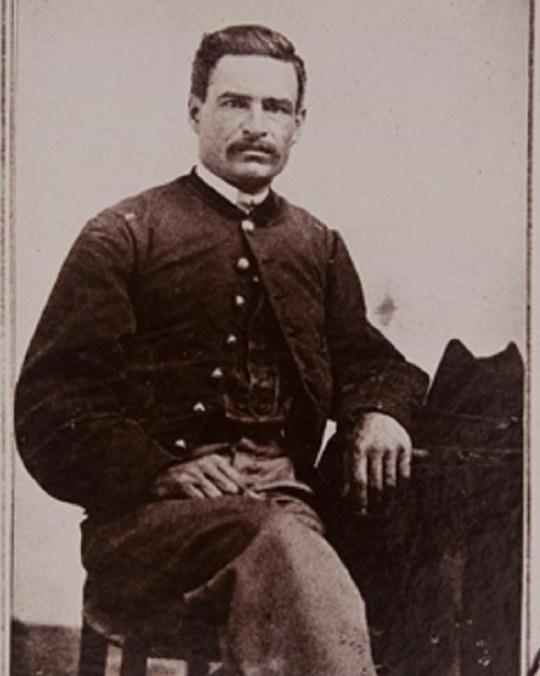
Born in Columbia, Pennsylvania in 1823, Stephen Atkins Swails grew up in south central Pennsylvania and western New York. In the years before his birth, Swails’ parents, freed persons from the slave state of Maryland, moved the family from the dangerous border state to Lancaster, Pennsylvania.
Following the Fugitive Slave Act of 1850, abolitionists and slave catchers frequently fought over the area. To avoid additional risks, Swails and his family relocated to the abolitionist center of Elmira, New York.
Swails worked as a waiter in Cooperstown, New York in April 1861 when the Civil War began. Swails shared the desire to serve in the war with other African American men who realized that it could radically change their status in the United States. However, the government prohibited their enlistment until the Lincoln administration issued the Emancipation Proclamation in 1863, which paved the way for Black men to serve in the military. Massachusetts soon began recruitment for the 54th Regiment, one of the first Black regiments of the Civil War, and enlisted the help of abolitionist leaders including Frederick Douglass to help fill its ranks. Douglass toured the Elmira area in the winter of 1863 as part of his recruitment tour. Likely inspired by Douglass‘s recruiting drives, Swails and hundreds of African Americans from New York and Pennsylvania enlisted in the new 54th Massachusetts Volunteer Infantry Regiment. They trained at Camp Meigs in the Boston area before heading to the warfront.
Recognizing Swail’s leadership ability, the regiment’s young colonel, Robert Gould Shaw, quickly promoted him to 1st Sergeant. During the 54th's heroic assault on Fort Wagner, South Carolina, Swails cradled the body of K company commander as he died and rallied the retreating regiment.
A defining moment for Swails came at Olustee, Florida on February 20, 1864. During the battle, he rallied the regiment and retreating Union forces, receiving a serious wound. While the 54th commanding officer recommended Swails for a promotion to 1st Lieutenant, racism within the military slowed the promotion for nearly a year. Despite emancipation and the disintegration of slavery, the basic idea that a Black man could lead White troops in battle struck at the heart of American racist attitudes. Captain Luis Emilio wrote, “When the usual request was made, it was refused on account of Swails African descent, although to all appearances he was a white man.” White officers in the regiment, such as Lt. Charles During, struggled to reconcile their own racism with the heroism of Black soldiers they witnessed on the battlefield and their belief that African Americans should not give orders to White soldiers. White officers gradually came to view their Black comrades with respect as they witnessed their bravery in battle. In January 1865, Swails finally received official promotion to officer rank. Though likely the only Black officer to receive this promotion, Swails never officially commanded in combat as the war soon ended without another major military engagement for the 54th.
Reconstruction enabled Swails to rise to political prominence in post-war South Carolina. Elected to the state senate in 1868, he served continually for nearly 10 years. Swails became the most prominent member of the South Carolina senate, the president pro tempore, placing him in control of all bills that passed through the state legislature. Committed to universal education, he played a critical part in transforming The South Carolina College from a school for planter elite into the integrated University of South Carolina.
Support for the Reconstruction governments faltered despite Swails’s direct appeals to President Grant in 1872. Local militias violently overthrew the state’s Reconstruction government in 1876, and the final federal troops withdrew the next year. The restoration of the former Confederates to power ended Black political influence in the state. Some Black politicians, including Swails, continued to have local influence, however the leadership of the state targeted his reputation and his life. In 1878, he survived two assassination attempts, forcing him to limit time in the state. Despite continued threats, Swails returned to South Carolina in 1884 to run for Congress. Unable to campaign due to the danger, he lost the election.
Swails died in Kingstree, South Carolina on May 17, 1900. His gravesite in the segregated Humane and Friendly Society Cemetery in Charleston remained unmarked until the 1970s. (x)
#stephen a swails#american civil war#54th Massachusetts#reconstruction#us history#acw#history#it drove me nuts that i coulnd't find a highquality photo of swails#but you know i don't care cause i had to post about him#gordon rhea came out with a great new book about him if you're interested to learn more!
5 notes
·
View notes
Photo


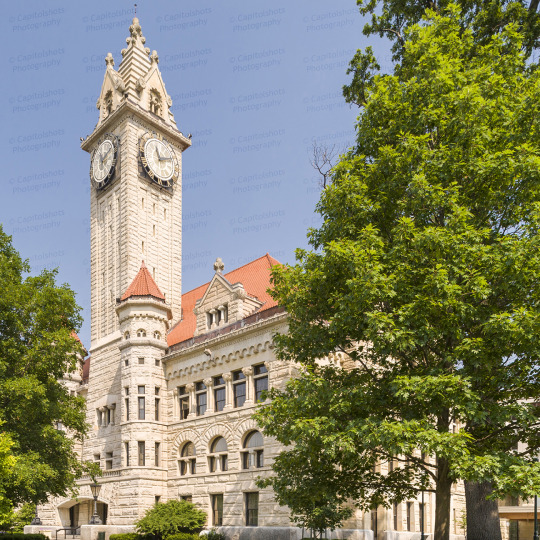

Wood County Courthouse
1 Court House Square
Bowling Green, OH 43402
The Wood County Courthouse and Jail, located in Bowling Green, Ohio, is Wood County's third courthouse. It was built after citizens decided to move the county seat from Perrysburg to Bowling Green. Ground was broken on November 28, 1893, and the cornerstone was laid on July 4, 1894. Joseph W. Yost and Frank L. Packard from the architectural firm of Yost & Packard of Columbus designed the courthouse and construction was overseen by T.B. Townsend of Youngstown. The winning tender for the project was $153,803 and the final construction costs totaled $255,746. The County Commissioners took possession of the new building on August 31, 1896, and the new Common Pleas Courtroom was dedicated on September 7, 1896.
Sandstone from Amherst, Ohio, granite from Vermont, and marble from Italy were used in the construction of the courthouse. Architecturally, it is Richardsonian Romanesque in design with architectural sculpting throughout the building done by Whyte and Priest of Dayton, Ohio. To facilitate construction, a temporary railroad along Pike Street was established to the construction site. Ornate stained glass panels cover much of the ceiling on the third floor and are visible from ground level due to the large open staircase which ascends through the middle of the second floor. The staircase consists of polished marble steps with brass railings.
The clock tower rises to a height of 195 feet. At the time of its construction, the clock hands were the second largest in America spanning 16 feet in diameter. They were exceeded only by the hands on the clock of the Chronicle newspaper building in San Francisco which were 16.5 feet in diameter. The clock was made by the E. Howard & Co. at a cost of $3000. The clock tower bells weigh 2,000 lb (910 kg).
Murals decorate the east and west walls of the third floor. The murals were painted by I. M. Taylor, who was the mayor of Bowling Green from 1911 to 1920. The east wall depicts Fort Meigs, a vital outpost in the War of 1812, and the west wall depicts a train passing through oil derricks in southern Wood County, a major producer of oil in the late 19th century.
A major restoration of the interior of the courthouse was undertaken in 1980, and a restoration of the exterior of the building was completed in 2002. President William Howard Taft held a rally at the courthouse in 1912. Jimmy Hoffa visited the courthouse on September 25, 1937 to get a marriage license, and married his wife in Bowling Green the same day. President Ronald Reagan delivered a speech at the courthouse on October 19, 1988 to promote the candidacy of George H. W. Bush. The building, located at 1 Courthouse Square in the county seat of Bowling Green, is still in use and today houses the Wood County Court of Common Pleas and its probate and domestic relations divisions.
There are two common pleas courtrooms and accompanying judicial offices located on the third floor as well as a jury assembly room, holding cell and conference rooms. A probate courtroom and judicial offices are located on the second floor, as is the Clerk of Courts Office. The first floor houses court security, court administration and a domestic relations courtroom with magistrates' offices and conference rooms. A five-story office building adjoining the courthouse contains a third common pleas courtroom and judicial offices as well as other county offices including the auditor, treasurer, engineer, commissioners, prosecutor, adult probation, building inspection and board of elections. A glass-enclosed atrium joining the courthouse and office building was completed in 2004. At that time existing entrances and exits to both buildings were closed and the atrium became the only public entrance to either building. It is staffed by court security who monitor people entering the buildings.
The clock tower is still in use. The original chimes are in working order and ring the hour, every hour, by denoting one chime per hour. All four clockfaces are quite remarkable, with two layers of Roman numerals. The inner layer closest to the center is golden and can be viewed easily when in shade. The outer ring on numerals is painted black iron which is easily readable when in direct sunlight. The tower also contains a box designed for use by nesting falcons. Construction of the old Wood County Jail, located next to the courthouse, was begun on May 21, 1901, and completed in 1902 at a cost of $49,000. The Fremont firm of Fronizer and Andrews constructed the building, which continued in use as the county jail until 1990.
Wood County is named after Maj. Eleazer D. Wood, an American Army officer in the War of 1812. Wood built Fort Meigs, which was located near Perrysburg, in 1813. This was used by American soldiers during the war to repel British attacks in the spring and summer of 1813. The courthouse was placed on the National Register of Historic Places in 1974.
2 notes
·
View notes
Text
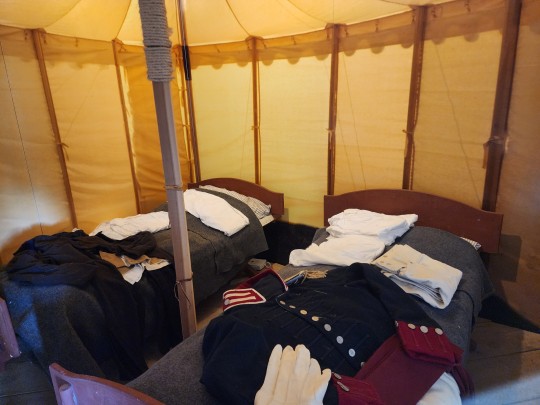
And there was only one tent for two officers' beds...
50 notes
·
View notes
Text
Diabloceratops eatoni
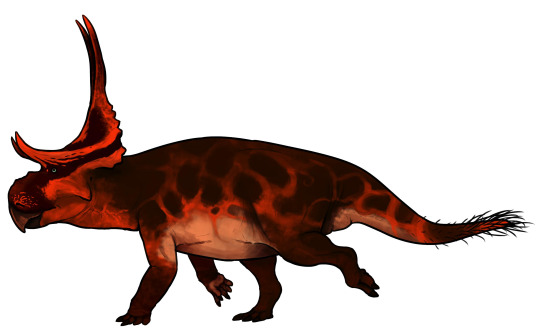
By Jack Wood
Etymology: Devil Horned Face
First Described By: Kirkland et al., 2010
Classification: Dinosauromorpha, Dinosauriformes, Dracohors, Dinosauria, Ornithischia, Genasauria, Neornithischia, Cerapoda, Marginocephalia, Ceratopsia, Neoceratopsia, Coronosauria, Ceratopsoidea, Ceratopsidae, Centrosaurinae?
Status: Extinct
Time and Place: Between 81 and 79 million years ago, in the Campanian of the Late Cretaceous


Diabloceratops is known from the lower and middle members of the Wahweap Formation of Utah

Physical Description: Diabloceratops is one of the most completely visually distinctive Ceratopsids - like all members of this very samey group, its body was the same as the rest of them, but its head was distinctive enough to give it a famous name. Like other Ceratopsids, Diabloceratops had four squat legs, a thick torso, and a short tail. It had a long head, with a large crest and a giant beak in the front of its snout, as well as teeth well built for chewing. The interesting thing about this Ceratopsid is that, while it has small brow horns like most early members of this group, it also had two very noticeable horns coming out of its frills - curving away from each other, the left one curving out to the left and the right one curving out to the right. This gave Diabloceratops the very distinctive look of… well, the Christian depiction of Satan. Hence its name, Devil Horned Face! It had a lightly built skull, with a hole seen in earlier Ceratopsians than the later Ceratopsids, and its head was shorter and deeper than later members. The frill of Diabloceratops was kind of weird too - very tall and narrow, rather than wider as in later Ceratopsians. Diabloceratops was primarily scaly all over, though it is possible (especially given how early derived it was) that it had quills or feathery fluff on its tail like earlier Ceratopsians. It was probably about 5.5 meters long from head to tail.

By Nix, CC BY-NC 4.0
Diet: As a Ceratopsid, Diabloceratops probably fed primarily on plants, though it is possible that it supplemented its diet with meat from time to time for protein. It would focus on low-lying and medium-level plant material, less than a meter in height.

By Franz Anthony
Behavior: The frill and fancy spikes of Diabloceratops would have been primarily used in sexual display and other types of communication between members of the herd, especially since they were rather small all things considered. That being said, other Ceratopsians would use these features for defense, and it is thus likely that Diabloceratops did too, even though they didn’t evolve for such a purpose. Diabloceratops, like other Ceratopsians, would have been a very social animal, spending most of its life in herds with socially complex behavior. These herds would have aided Diabloceratops in defending itself from the local predator Lythronax, and any other predatory animals that may have attempted to attack it. Like other dinosaurs, Diabloceratops probably would have taken care of its young, and the social group would have aided it in doing so. Being a large herbivore with deadly weapons on its face, Diabloceratops would have been a very aggressive animal, not trusting anything that got too close to it or its family. It is possible that Diabloceratops herds also migrated too and from the Western Interior Seaway, based on the seasonal rainfall.

By Sam Stanton
Ecosystem: The Wahweap Formation is one of the earliest environments we know of from the charismatic and iconic Late Cretaceous North American faunas - those ecosystems from the Campanian and Maastrichtian which featured Ceratopsians, Hadrosaurs, and Ankylosaurs a plenty, all being preyed upon by terrifying Tyrannosaurs. Weirdly enough, this unique makeup of these ecosystems is unique to North America - while Hadrosaurs could be found elsewhere somewhat, both Tyrannosaurs and Ceratopsids were very rare elsewhere, Ceratopsids especially so. Instead, the world was frequented with many other kinds of large predatory dinosaurs (especially Abelisaurids), and Titanosaurs were some of the most common large herbivores. But I am getting off track - the Wahweap Formation is one of the earliest of these charismatic locations, and as expected, it has some of the earliest members of these groups to branch off, including Diabloceratops. The Wahweap Formation began as a very dry ecosystem, filled with sand and very brief wet seasons; over time, it became a pond ecosystem and - by the time Diabloceratops disappeared - a very fertile system of rivers running in from the Western Interior Seaway.

By Nathan E. Rogers, used with permission from Studio 252Mya
So, in the time of the earliest part of the formation, Diabloceratops was a living in an extremely seasonally varied environment, as it began to transition to more freshwater being present in later millenia from its earlier dry beginnings. The diversity of the later environments, however, was lacking in the earliest one. Here, Diabloceratops was preyed upon by Lythronax, and while some mammals, turtles, and crocodylomorphs were present, it is entirely possible that the great diversity of mammals and other animals to be found later wasn’t present quite yet. In the middle environment, when the ponds were coming in and things were getting more lush, Lythronax was gone - but now Diabloceratops was accompanied by the Hadrosaur Acristavus, similar to the later Maiasaura. There were many non-dinosaurs too, like turtles, though it is uncertain if the many mammals found in Wahweap are from the middle, lower, or upper parts of this environment.

By Nix, CC BY-NC 4.0
Interestingly enough, one of Diabloceratops’ closest relatives, Machairoceratops, is known from the upper unit of this formation - indicating that it is possible that Diabloceratops evolved into Machairoceratops, and never really disappeared from the environment at all.

By José Carlos Cortés
Other: Diabloceratops is usually found to be a Centrosaurine, the group of Ceratopsids with prominent nose horns and frill ornamentation, and usually little to no brow horns. However, a very recent analysis of Ceratopsian relationships found Diabloceratops to be neither a Centrosaurine nor a Chasmosarine (the other group of Ceratopsians, which includes Triceratops and its closest relatives), but rather outside both. Either way, Diabloceratops was a very early Ceratopsids, showing characteristics that are often found in common between both of the major groups of these dinosaurs - and showing how weird their headgear got even early on in their evolution.
~ By Meig Dickson
Sources Under the Cut
Chiba, K.; Michael J. Ryan; Federico Fanti; Mark A. Loewen; David C. Evans (2018). "New material and systematic re-evaluation of Medusaceratops lokii (Dinosauria, Ceratopsidae) from the Judith River Formation (Campanian, Montana)". Journal of Paleontology. in press (2): 272–288.
Dalman, Sebastian G.; Hodnett, John-Paul M.; Lichtig, Asher J.; Lucas, Spencer G. (2018). "A new ceratopsid dinosaur (Centrosaurinae: Nasutoceratopsini) from the Fort Crittenden Formation, Upper Cretaceous (Campanian) of Arizona". New Mexico Museum of Natural History and Science Bulletin. 79: 141–164.
De Blieux, Donald D. 2007. Analysis of Jim's hadrosaur site; a dinosaur site in the middle Campanian (Cretaceous) Wahweap Formation of Grand Staircase-Escalante National Monument (GSENM), southern Utah. Abstracts with Programs – Geological Society of America 39 (5): 6.
Eaton, J. G., R. L. Cifelli. 2005. Review of Cretaceous mammalian paleontology; Grand Staircase-Escalante National Monument, Utah. Abstracts with Programs - Geological Society of America 37 (7): 115.
Evans, D. C., and M. J. Ryan. 2015. Cranial anatomy of Wendiceratops pinhornensis gen. et sp. nov., a centrosaurine ceratopsid (Dinosauria: Ornithischia) from the Oldman Formation (Campanian), Alberta, Canada, and the evolution of ceratopsid nasal ornamentation. PLoS ONE 10(7):e0130007
Farke, A. A. 2011. Anatomy and taxonomic status of the chasmosaurine ceratopsid Nedoceratops hatcheri from the Upper Cretaceous Lance Formation of Wyoming, U.S.A. PLoS One 6(1(e16196)):1-9
Farke, A. A., M. J. Ryan, P. M. Barrett, D. H. Tanke, D. R. Braman, M. A. Loewen, and M. R. Graham. 2011. A new centrosaurine from the Late Cretaceous of Alberta, Canada, and the evolution of parietal ornamentation in horned dinosaurs. Acta Palaeontologica Polonica 56(4):691-702
Fiorillo, A. R., and R. S. Tykoski. 2012. A new Maastrichtian species of the centrosaurine ceratopsid Pachyrhinosaurus from the North Slope of Alaska. Acta Palaeontologica Polonica 57(3):561-573
Fowler, D. W. 2017. Revised geochronology, correlation, and dinosaur stratigraphic ranges of the Santonian-Maastrichtian (Late Cretaceous) formations of the Western Interior of North America. PLoS ONE 12 (11): e0188426.
Gates, T.A.; Horner, J.R.; Hanna, R.R.; Nelson, C.R. (2011). "New unadorned hadrosaurine hadrosaurid (Dinosauria, Ornithopoda) from the Campanian of North America". Journal of Vertebrate Paleontology. 31 (4): 798–811.
Gates, Jinnah, Levitt, and Getty, 2014. New hadrosaurid specimens from the lower-middle Campanian Wahweap Formation of southern Utah. pp. 156–173. In The Hadrosaurs: Proceedings of the International Hadrosaur Symposium (D. A. Eberth and D. C. Evans, eds), Indiana University Press, Bloomington.
Getty, M. A., M. A. Loewen, E. M. Roberts, A. L. Titus, and S. D. Sampson. 2010. Taphonomy of horned dinosaurs (Ornithischia: Ceratopsidae) from the late Campanian Kaiparowits Formation, Grand Staircase-Escalante National Monument, Utah. In M. J. Ryan, B. J. Chinnery-Allgeier, D. A. Eberth (eds.), New Perspectives on Horned Dinosaurs: The Royal Tyrrell Museum Ceratopsian Symposium. Indiana University Press, Bloomington 478-494
Hone, D.W.E.; Naish, D.; Cuthill, I.C. (2011). “Does mutual sexual selection explain the evolution of head crests in pterosaurs and dinosaurs?” (PDF). Lethaia. 45 (2): 139–156.
Glut, D. F., 2012, Dinosaurs, the Encyclopedia, Supplement 7: McFarland & Company, Inc, 866pp.
Kentaro Chiba; Michael J. Ryan; Federico Fanti; Mark A. Loewen; David C. Evans (2018). "New material and systematic re-evaluation of Medusaceratops lokii (Dinosauria, Ceratopsidae) from the Judith River Formation (Campanian, Montana)". Journal of Paleontology. in press (2): 272–288.
Kirkland, J. I. 2005. An inventory of paleontological resources in the lower Wahweap Formation (lower Campanian), southern Kaiparowits Plateau, Grand Staircase-Escalante National Monument, Utah. Abstracts with Programs - Geological Society of America 37 (7): 114.
Kirkland, J. I., and D. D. DeBlieux. 2007. New horned dinosaurs from the Wahweap Formation, Grand Staircase-Escalante National Monument, southern Utah. Utah Geological Survey Notes 39(3):4-5
Kirkland, J. I., and D. D. Deblieux. 2010. New basal centrosaurine ceratopsian skulls from the Wahweap Formation (middle Campanian), Grand Staircase-Escalante National Monument, southern Utah. New Perspectives on Horned Dinosaurs: The Royal Tyrrell Museum Ceratopsian Symposium. Indiana University Press, Bloomington 117-140
Loewen, M. A., R. B. Irmis, J. J. W. Sertich, P. J. Currie, and S. D. Sampson. 2013. Tyrant dinosaur evolution tracks the rise and fall of Late Cretaceous oceans. PLoS ONE 8(11):e79420
Lund, E. K., P. M. O'Connor, M. A. Loewen and Z. A. Jinnah. 2016. A new centrosaurine ceratopsid, Machairoceratops cronusi gen et sp. nov., from the Upper Sand Member of the Wahweap Formation (Middle Campanian), southern Utah. PLoS ONE 11(5):e0154403:1-21
Mallon, Jordan C; David C Evans; Michael J Ryan; Jason S Anderson (2013). [tp://link.springer.com/article/10.1186/1472-6785-13-14 “Feeding height stratification among the herbivorous dinosaurs from the Dinosaur Park Formation (upper Campanian) of Alberta, Canada”]. BMC Ecology. 13: 14.
Orsulak, M. 2007. A lungfish burrow in late Cretaceous upper capping sandstone member of the Wahweap Formation Cockscomb area, Grand Staircase-Escalante National Monument, Utah. Abstracts with Programs - Geological Society of America 39 (5): 43.
Sampson, S. D., 2001, Speculations on the socioecology of Ceratopsid dinosaurs (Orinthischia: Neoceratopsia): In: Mesozoic Vertebrate Life, edited by Tanke, D. H., and Carpenter, K., Indiana University Press, pp. 263–276.
Simpson, Edward L.; Hilbert-Wolf, Hannah L.; Wizevich, Michael C.; Tindall, Sarah E.; Fasinski, Ben R.; Storm, Lauren P.; Needle, Mattathias D. (2010). "Predatory digging behavior by dinosaurs". Geology. 38 (8): 699–702.
Tester, E. 2007. Isolated vertebrate tracks from the Upper Cretaceous capping sandstone member of the Wahweap Formation; Grand Staircase-Escalante National Monument, Utah. Abstracts with Programs - Geological Society of America 39 (5): 42.
Thompson, C. R. 2004. A preliminary report on biostratigraphy of Cretaceous freshwater rays, Wahweap Formation and John Henry Member of the Straight Cliffs Formation, southern Utah. Abstracts with Programs - Geological Society of America 36 (4): 91.
Weishampel, David B; et al. (2004). "Dinosaur distribution (Late Cretaceous, North America)." In: Weishampel, David B.; Dodson, Peter; and Osmólska, Halszka (eds.): The Dinosauria, 2nd, Berkeley: University of California Press. Pp. 574–588.
Williams, J. A. J., C. F. Lohrengel. 2007. Preliminary study of freshwater gastropods in the Wahweap Formation, Bryce Canyon National Park, Utah. Abstracts with Programs - Geological Society of America 39 (5): 43.
Zubair A. Jinnah, #30088 (2009)Sequence Stratigraphic Control from Alluvial Architecture of Upper Cretaceous Fluvial System - Wahweap Formation, Southern Utah, U.S.A. Search and Discovery Article #30088. Posted June 16, 2009.
#Diabloceratops eatoni#Diabloceratops#Dinosaur#Ceratopsian#Palaeoblr#Factfile#Ceratopsid#Mesozoic Monday#Herbivore#Cretaceous#North America#paleontology#prehistory#prehistoric life#dinosaurs#biology#a dinosaur a day#a-dinosaur-a-day#dinosaur of the day#dinosaur-of-the-day#science#nature
410 notes
·
View notes
Photo

Portrait of Angus Lewis Langham, who was born in Virginia around 1781. His father was a Revolutionary War soldier who’d been granted 333.5 acres of land in the Virginia Military District for his services, and the family moved to Chillicothe, Ohio in 1798. He was described by a contemporary there as “buoyant, full of life, and a great favorite in society.”
Angus served as captain of a company in the 19th US Regiment of Infantry during the War of 1812, and was present for the Seige of Fort Meigs and the battle of River Raisin.
After his retirement in 1816, he moved to Arkansas, where his brother had been appointed by Andrew Jackson as a surveyor of public lands. His diary of one of the exploration expeditions comprises an important part of the early historical record. He may have also once acted as a second in a duel near what is New Madrid today.
Angus became a surveyor himself, and a land speculator. He was one of the founders of the town of Osage. He died suddenly of unknown causes in 1834 in Little Rock.
#angus lewis langham#chillicothe#chillicothe ohio#war of 1812#osage#seige of fort meigs#battle of river raisin
4 notes
·
View notes
Text
American Revolutionary War battles
Recently they did work on history, wrote an essay on the theme of revolutionary wars in America. A lot of blood has been shed on our land, war is evil. It begins in offices and ends there, but hundreds of thousands of young people die. Here is a list of battles, sorted by chronology.
Battle Date Colony/State Outcome
Powder Alarm
* September 1, 1774 Massachusetts British soldiers remove military supplies
Storming of Fort William and Mary
* December 14, 1774 New Hampshire Patriots seize powder and shot after brief skirmish.
Battles of Lexington and Concord
April 19, 1775 Massachusetts Patriot victory: British forces raiding Concord driven back into Boston with heavy losses.
Siege of Boston
April 19, 1775 –
March 17, 1776 Massachusetts Patriot victory: British eventually evacuate Boston after Patriots fortify Dorchester heights
Gunpowder Incident
* April 20, 1775 Virginia Virginia governor Lord Dunmore removes powder to a Royal Navy ship, standoff is resolved peacefully
Capture of Fort Ticonderoga
May 10, 1775 New York Patriot victory: Patriots capture British posts at Ticonderoga and Crown point
Battle of Chelsea Creek
May 27–28, 1775 Massachusetts Patriots victory: Patriots capture British ship Diana
Battle of Machias
June 11–12, 1775 Massachusetts Patriot forces capture the HM schooner Margaretta
Battle of Bunker Hill
June 17, 1775 Massachusetts British victory: British drive Patriot army from the Charlestown peninsula near Boston but suffer heavy losses
Battle of Gloucester
August 8, 1775 Massachusetts Patriot victory
Siege of Fort St. Jean
September 17 –
November 3, 1775 Quebec Patriot victory: Patriots capture British force and subsequently overrun Montreal and much of Quebec
Burning of Falmouth
October 18, 1775 Massachusetts British burn Falmouth
Battle of Kemp's Landing
November 14, 1775 Virginia British victory
Siege of Savage's Old Fields
November 19–21, 1775 South Carolina Patriot victory: Patriots defeat loyalist force
Battle of Great Bridge
December 9, 1775 Virginia Patriot victory: Lord Dunmore's loyalist force is defeated
Snow Campaign
December 1775 South Carolina Patriot campaign against loyalists in South Carolina
Battle of Quebec
December 31, 1775 Quebec British victory: British repulse Patriot assault on Quebec city
Burning of Norfolk
January 1, 1776 Virginia British bombard Norfolk and Patriots destroy what they see as a loyalist stronghold
Battle of Moore's Creek Bridge
February 27, 1776 North Carolina Patriot victory: loyalist force of Regulators and Highlanders defeated
Battle of the Rice Boats
March 2–3, 1776 Georgia British victory
Battle of Nassau
March 3–4, 1776 Bahamas Patriots raid against the Bahamas to obtain supplies
Battle of Saint-Pierre
March 25, 1776 Quebec Patriot victory
Battle of Block Island
April 6, 1776 Rhode Island British victory
Battle of The Cedars
May 18–27, 1776 Quebec British victory
Battle of Trois-Rivières
June 8, 1776 Quebec British victory: Patriots forced to evacuate Quebec
Battle of Sullivan's Island
June 28, 1776 South Carolina Patriot victory: British attack on Charleston is repulsed
Battle of Turtle Gut Inlet
June 29, 1776 New Jersey Patriot victory
Battle of Lindley's Fort
July 15, 1776 South Carolina Patriot victory: Native Americans attack repulsed
Battle of Long Island
August 27, 1776 New York British victory: in the largest battle of the war the Patriot army is outflanked and routed on Long Island but later manages to evacuate to Manhattan
Landing at Kip's Bay
September 15, 1776 New York British victory: British capture New York City
Battle of Harlem Heights
September 16, 1776 New York Patriot victory: Patriots repulse British attack on Manhattan
Battle of Valcour Island
October 11, 1776 New York British victory: British defeat Patriot naval force on Lake Champlain, but victory comes too late to press the offensive against the Hudson valley
Battle of White Plains
October 28, 1776 New York British victory
Battle of Fort Cumberland
November 10–29, 1776 Nova Scotia British victory
Battle of Fort Washington
November 16, 1776 New York British victory: British capture 3,000 Patriots on Manhattan in one of the most devastating Patriot defeats of the war
Battle of Fort Lee
November 20, 1776 New Jersey British victory: Patriots begin general retreat
Ambush of Geary
December 14, 1776 New Jersey Patriot victory
Battle of Iron Works Hill
December 22–23, 1776 New Jersey British victory
Battle of Trenton
December 26, 1776 New Jersey Patriot victory: Patriots capture Hessian detachment at Trenton
Second Battle of Trenton
January 2, 1777 New Jersey Patriot victory
Battle of Princeton
January 3, 1777 New Jersey Patriot victory: Patriots defeat a small British force, the British decide to evacuate New Jersey
Battle of Millstone
January 20, 1777 New Jersey Patriot victory
Forage War
January–March 1777 New Jersey Patriots harass remaining British forces in New Jersey
Battle of Punk Hill
March 8, 1777 New Jersey Patriot victory
Battle of Bound Brook
April 13, 1777 New Jersey British victory
Battle of Ridgefield
April 27, 1777 Connecticut British victory
Battle of Thomas Creek
May 17, 1777 East Florida British victory
Meigs Raid
May 24, 1777 New York Patriot victory
Battle of Short Hills
June 26, 1777 New Jersey British victory
Siege of Fort Ticonderoga
July 5–6, 1777 New York British victory
Battle of Hubbardton
July 7, 1777 Vermont British victory
Battle of Fort Ann
July 8, 1777 New York British victory
Siege of Fort Stanwix
August 2–23, 1777 New York Patriot victory: British fail to take Fort Stanwix
Battle of Oriskany
August 6, 1777 New York British victory
Second Battle of Machias
August 13–14, 1777 Massachusetts British victory
Battle of Bennington
August 16, 1777 New York Patriot victory
Battle of Staten Island
August 22, 1777 New York British victory
Battle of Setauket
August 22, 1777 New York British victory
First Siege of Fort Henry
September 1 or 21, 1777 Virginia Patriot victory
Battle of Cooch's Bridge
September 3, 1777 Delaware British victory
Battle of Brandywine
September 11, 1777 Pennsylvania British victory
Battle of the Clouds
September 16, 1777 Pennsylvania Battle called off due to rain
Battle of Freeman's Farm
September 19, 1777 New York British tactical victory: First of the two
Battles of Saratoga
Battle of Paoli
September 21, 1777 Pennsylvania British victory
Siege of Fort Mifflin
September 26 –
November 15, 1777 Pennsylvania British victory
Battle of Germantown
October 4, 1777 Pennsylvania British victory
Battle of Forts Clinton and Montgomery
October 6, 1777 New York British victory
Battle of Bemis Heights
October 7, 1777 New York Patriot victory: Second of the two
Battles of Saratoga
, British under Burgoyne driven back and forced to surrender 10 days later
Battle of Red Bank
October 22, 1777 New Jersey Patriot victory
Battle of Gloucester
November 25, 1777 New Jersey Patriot victory
Battle of White Marsh
December 5–8, 1777 Pennsylvania Patriot victory
Battle of Matson's Ford
December 11, 1777 Pennsylvania British victory
Battle of Barbados
March 7, 1778 Barbados British victory
Battle of Quinton's Bridge
March 18, 1778 New Jersey British victory
North Channel Naval Duel
April 24, 1778 Great Britain Patriot victory
Battle of Crooked Billet
May 1, 1778 Pennsylvania British victory
Battle of Barren Hill
May 20, 1778 Pennsylvania Indecisive
Mount Hope Bay raids
May 25–30, 1778 Rhode Island British victory
Battle of Cobleskill
May 30, 1778 New York British-Iroquois victory
Battle of Monmouth
June 28, 1778 New Jersey Draw: British break off engagement and continue retreat to New York
Battle of Alligator Bridge
June 30, 1778 East Florida British victory
Wyoming Massacre
July 3, 1778 Pennsylvania British-Iroquois victory
First Battle of Ushant
July 27, 1778 Bay of Biscay Indecisive
Siege of Pondicherry
August 21–October 19, 1778 India British victory
Battle of Newport
August 29, 1778 Rhode Island British victory
Grey's raid
September 5–17, 1778 Massachusetts British victory
Invasion of Dominica
September 7, 1778 Dominica French victory
Siege of Boonesborough
September 7, 1778 Virginia Patriot victory
Attack on German Flatts
September 17, 1778 New York British-Iroquois victory
Baylor Massacre
September 27, 1778 New Jersey British victory
Raid on Unadilla and Onaquaga
October 2–16, 1778 Indian Reserve Patriot victory
Battle of Chestnut Neck
October 6, 1778 New Jersey British victory
Little Egg Harbor massacre
October 16, 1778 New Jersey British victory
Carleton's Raid
October 24-November 14, 1778 Vermont British victory
Cherry Valley Massacre
November 11, 1778 New York British-Iroquois victory
Battle of St. Lucia
December 15, 1778 St. Lucia British victory
Capture of St. Lucia
December 18–28, 1778 St. Lucia British victory
Capture of Savannah
December 29, 1778 Georgia British victory
Battle of Beaufort
February 3, 1779 South Carolina Patriot victory
Battle of Kettle Creek
February 14, 1779 Georgia Patriot victory
Siege of Fort Vincennes
February 23–25, 1779 Indiana Patriot victory
Battle of Brier Creek
March 3, 1779 Georgia British victory
Battle of Chillicothe
May 1779 Quebec Patriot victory
Chesapeake raid
May 10–24, 1779 Virginia British victory
Capture of Saint Vincent
June 16–18, 1779 St. Vincent French victory
Battle of Stono Ferry
June 20, 1779 South Carolina British victory
Great Siege of Gibraltar
June 24, 1779 – February 7, 1783 Gibraltar British victory
Capture of Grenada
July 2, 1779 Grenada French victory
Tryon's raid
July 5–14, 1779 Connecticut British victory
Battle of Grenada
July 6, 1779 Grenada French victory
Battle of Stony Point
July 16, 1779 New York Patriot victory
Battle of Minisink
July 22, 1779 New York British-Iroquois victory
Penobscot Expedition
July 24-August 29, 1779 Massachusetts British victory
Battle of Paulus Hook
August 19, 1779 New Jersey Patriot victory
Battle of Newtown
August 29, 1779 Indian Reserve Patriot victory
Capture of Fort Bute
September 7, 1779 West Florida Patriot-Spanish victory
Battle of Lake Pontchartrain
September 10, 1779 West Florida Patriot victory
Boyd and Parker ambush
September 13, 1779 Indian Reserve British-Iroquois victory
Action of 14 September 1779
September 14, 1779 Azores British victory
Siege of Savannah
September 16-October 18, 1779 Georgia British victory
Battle of Baton Rouge
September 20–21, 1779 West Florida Patriot-Spanish victory
Battle of Flamborough Head
September 23, 1779 Great Britain Patriot victory
Battle of San Fernando de Omoa
October 16-November 29, 1779 Guatemala British victory
Action of 11 November 1779
November 11, 1779 Portugal British victory
First Battle of Martinique
December 18, 1779 Martinique British victory
Action of 8 January 1780
January 8, 1780 Spain British victory
Battle of Cape St. Vincent
January 16, 1780 Portugal British victory
Battle of Young's House
February 3, 1780 New York British victory
San Juan Expedition
March–November, 1780 Guatemala Patriot-Spanish victory
Battle of Fort Charlotte
March 2–14, 1780 West Florida Patriot-Spanish victory
Siege of Charleston
March 29-May 12, 1780 South Carolina British victory: British recapture South Carolina following the battle
Battle of Monck's Corner
April 14, 1780 South Carolina British victory
Second Battle of Martinique
April 17, 1780 Martinique Patriot victory
Battle of Lenud's Ferry
May 6, 1780 South Carolina British victory
Bird's invasion of Kentucky
May 25-August 4, 1780 Virginia British victory
Battle of St. Louis
May 25, 1780 Louisiana Patriot-Spanish victory
Battle of Waxhaws
May 29, 1780 South Carolina British victory
Battle of Connecticut Farms
June 7, 1780 New Jersey British victory
Battle of Mobley's Meeting House
June 10–12, 1780 South Carolina Patriot victory
Battle of Ramsour's Mill
June 20, 1780 North Carolina Patriot victory
Battle of Springfield
June 23, 1780 New Jersey Patriot victory
Huck's Defeat
July 12, 1780 South Carolina Patriot victory
Battle of Bull's Ferry
July 20–21, 1780 New Jersey Loyalist victory
Battle of Colson's Mill
July 21, 1780 North Carolina Patriot victory
Battle of Rocky Mount
August 1, 1780 South Carolina Loyalist victory
Battle of Hanging Rock
August 6, 1780 South Carolina Patriot victory
Battle of Pekowee
August 8, 1780 Quebec Patriot victory
Action of 9 August 1780
August 9, 1780 Atlantic Spanish victory
Battle of Camden
August 16, 1780 South Carolina British victory
Battle of Fishing Creek
August 18, 1780 South Carolina British victory
Battle of Musgrove Mill
August 18, 1780 South Carolina Patriot victory
Battle of Black Mingo
August 28, 1780 South Carolina Patriot victory
Battle of Wahab's Plantation
September 20, 1780 South Carolina Patriot victory
Battle of Charlotte
September 26, 1780 North Carolina British victory
Battle of Kings Mountain
October 7, 1780 South Carolina Patriot victory: halts first British invasion of North Carolina
Royalton Raid
October 16, 1780 Vermont British victory
Battle of Klock's Field
October 19, 1780 New York Patriot victory
La Balme's Defeat
November 5, 1780 Quebec British-Iroquois victory
Battle of Fishdam Ford
November 9, 1780 South Carolina Patriot victory
Battle of Blackstock's Farm
November 20, 1780 South Carolina Patriot victory
Battle of Fort St. George
November 23, 1780 New York Patriot victory
Battle of Jersey
January 6, 1781 Jersey British victory
Battle of Mobile
January 7, 1781 West Florida Patriot-Spanish victory
Battle of Cowpens
January 17, 1781 South Carolina Patriot victory
Battle of Cowan's Ford
February 1, 1781 North Carolina British victory
Capture of Sint Eustatius
February 3, 1781 Sint Eustatius British victory
Battle of Haw River
February 25, 1781 North Carolina Patriot victory
Battle of Wetzell's Mill
March 6, 1781 North Carolina British victory
Siege of Pensacola
March 9-May 8, 1781 West Florida Patriot-Spanish victory
Battle of Guilford Court House
March 15, 1781 North Carolina British victory
Battle of Cape Henry
March 16, 1781 Virginia British victory
Siege of Fort Watson
April 15–23, 1781 South Carolina Patriot victory
Battle of Porto Praya
April 15, 1781 Cape Verde Draw
Battle of Blandford
April 25, 1781 Virginia British victory
Battle of Hobkirk's Hill
April 25, 1781 South Carolina British victory
Battle of Fort Royal
April 29, 1781 Martinique French victory
Action of 1 May 1781
May 1, 1781 France British victory
Battle of Fort Motte
May 8–12, 1781 South Carolina Patriot victory
Siege of Augusta
May 22-June 6, 1781 Georgia Patriot victory
Siege of Ninety-Six
May 22-June 6, 1781 South Carolina British victory
Invasion of Tobago
May 24-June 2, 1781 Tobago French victory
Action of 30 May 1781
May 30, 1781 Barbary Coast British victory
Battle of Spencer's Ordinary
June 26, 1781 Virginia British victory
Francisco's Fight
July 1781 Virginia Patriot victory
Battle of Green Spring
July 6, 1781 Virginia British victory
Naval battle of Louisbourg
July 21, 1781 Nova Scotia Franco-Patriot victory
Battle of Dogger Bank
August 5, 1781 North Sea British victory
Invasion of Minorca
August 19, 1781 – February 5, 1782 Minorca Franco-Spanish victory
Lochry's Defeat
August 24, 1781 Quebec British-Iroquois victory
Battle of the Chesapeake
September 5, 1781 Virginia French victory
Battle of Groton Heights
September 6, 1781 Connecticut British victory
Battle of Eutaw Springs
September 8, 1781 South Carolina British victory
Battle of Lindley's Mill
September 13, 1781 North Carolina Patriot victory
Long Run Massacre
September 13, 1781 Virginia British-Iroquois victory
Siege of Yorktown
September 28-October 19, 1781 Virginia Franco-Patriot victory: Cornwallis surrenders his force of over 7,000
Battle of Fort Slongo
October 3, 1781 New York Patriot victory
Siege of Negapatam
October 21-November 11, 1781 India British victory
Battle of Johnstown
October 25, 1781 New York Patriot victory
Second Battle of Ushant
December 12, 1781 Bay of Biscay British victory
Battle of Videau's Bridge
January 2, 1782 South Carolina British victory
Siege of Brimstone Hill
January 11-February 13, 1782 St. Christopher Franco-Patriot victory
Capture of Trincomalee
January 11, 1782 Ceylon British victory
Capture of Demerara and Essequibo
January 22-February 5, 1782 Demerara and Essequibo Franco-Patriot victory
Battle of Saint Kitts
January 25–26, 1782 St. Christopher British victory
Battle of Sadras
February 17, 1782 India French victory
Capture of Montserrat
February 22, 1782 Montserrat French victory
Battle of Wambaw
February 24, 1782 South Carolina British victory
Gnadenhütten massacre
March 8, 1782 Ohio
Battle of Roatán
March 16, 1782 Guatemala Patriot-Spanish victory
Action of 16 March 1782
March 16, 1782 Strait of Gibraltar British victory
Battle of Little Mountain
March 22, 1782 Virginia British-Iroquois victory
Battle of Delaware Bay
April 8, 1782 New Jersey Patriot victory
Battle of the Saintes
April 9–12, 1782 Dominica British victory
Battle of Providien
April 12, 1782 Ceylon French victory
Battle of the Black River
April–August, 1782 Guatemala British victory
Battle of the Mona Passage
April 19, 1782 Mona passage British victory
Action of 20–21 April 1782
April 20–21, 1782 Bay of Biscay British victory
Capture of the Bahamas
May 6, 1782 Bahamas Patriot-Spanish victory
Crawford expedition
May 25-June 12, 1782 Quebec British-Iroquois victory
Naval battle off Halifax
May 28–29, 1782 Nova Scotia British victory
Raid on Lunenburg
July 1, 1782 Nova Scotia Patriot victory
Battle of Negapatam
July 6, 1782 Ceylon British victory
Hudson Bay Expedition
August 8, 1782 Rupert's Land Franco-Patriot victory
Siege of Bryan Station
August 15–17, 1782 Virginia Patriot victory
Battle of Blue Licks
August 19, 1782 Virginia British-Iroquois victory
Battle of the Combahee River
August 26, 1782 South Carolina British victory
Battle of Trincomalee
August 25-September 3, 1782 Ceylon French victory
Siege of Fort Henry
September 11–13, 1782 Virginia Patriot victory
Grand Assault on Gibraltar
September 13, 1782 Gibraltar British victory
Action of 18 October 1782
October 18, 1782 Hispaniola British victory
Action of 6 December 1782
December 6, 1782 Martinique British victory
Action of 22 January 1783
January 22, 1783 Virginia British victory
2 notes
·
View notes
Photo

Fort Meigs // Perrysburg // Ohio // USA
Fort Meigs is the largest reconstructed wooden-walled fort in the nation.
Fort Meigs was used to defend Ohio during the War of 1812. The British army failed to take the Fort during the Siege of Fort Meigs.
The grounds and blockhouses are full of interactive historical exhibits from wartime medical treatments and “Spin the Wheel to Find Out What Disease You Would Have Died From” to cannons and punishment stockades.
At the center of its walls is an obelisk monument, dedicated in 1908, in honor of fallen soldiers at Fort Meigs.
There is a great museum of historical artifacts, fun costumes and cutouts for photo-ops, and guides in period costumes re-enacting wartime customs.
And if you luck out you may even get to witness re-enactors demonstrate old-timey muskets.
This is a great day trip and a fascinating look into a part of Ohio’s history.
#travel#travel blog#travel photography#fort meigs#war of 1812#travel blogger#photography#ohio#ohio history
0 notes
